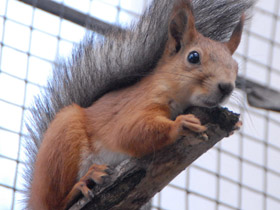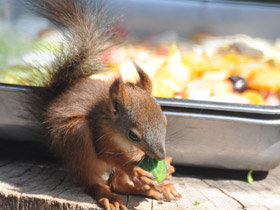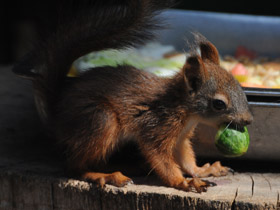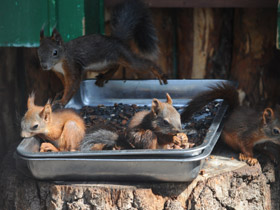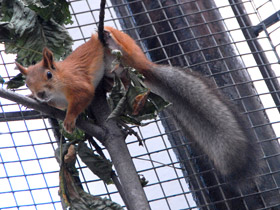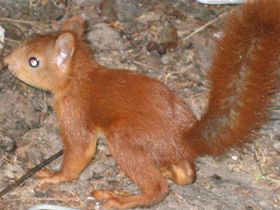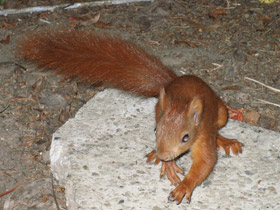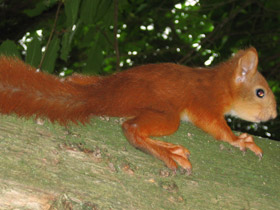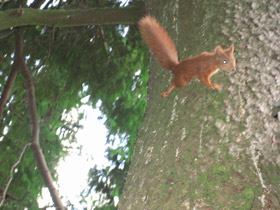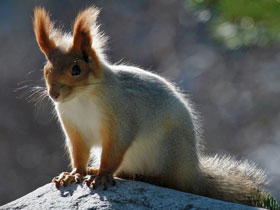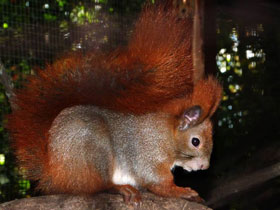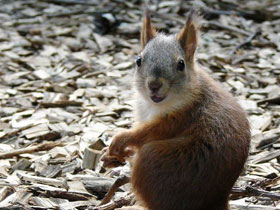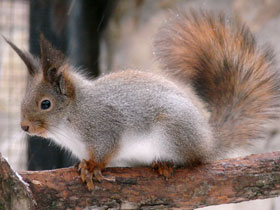The red squirrel or Eurasian red squirrel (Sciurus vulgaris)
The red squirrel or Eurasian red squirrel (Sciurus vulgaris) is a species of tree squirrel in the genus Sciurus common throughout Europe and Asia. The red squirrel is an arboreal, primarily herbivorous rodent.
In Great Britain, Ireland, and in Italy numbers have decreased drastically in recent years. This decline is associated with the introduction by humans of the eastern grey squirrel (Sciurus carolinensis) from North America. However, the population in Scotland is stabilising due to conservation efforts, awareness and the increasing population of the pine marten, a European predator that selectively controls grey squirrels.
Lifestyle and habits
Sciurus vulgaris is a small arboreal animal with a body length of up to 30 cm. The squirrel's fur is red in summer and changes to grey in winter, with tassels on the ears. A long (13-19 centimetres), very fluffy tail serves as a rudder for the squirrel when jumping from tree to tree. The animal is active during the daytime, and spends the night in hollow trees. In taiga it often builds a gaino - a spherical nest of branches up to half a metre in diameter with 1-2 side entrances, lined inside with moss and lichens. In severe frosts the squirrel may not leave the gyno for several days, but it never hibernates.
Habitat and food
Sciurus vulgaris feeds on conifer seeds, mushrooms, buds, shoots, nuts, insects, and occasionally eats chicks and eggs of birds. They feed in trees and on the ground, and can make long migrations through the crowns, almost never coming down to the ground. Taiga squirrels feed mainly on seeds of coniferous trees; an important role in their nutrition in bad harvest years is played by cones dropped on the ground by pinchers and seeds from the stocks of pine-trees; in deciduous forests the main food is nuts and acorns. In hungry years squirrels eat spruce buds, biting off the end shoots and dropping them on snow. A female brings 3-10 baby squirrels twice a year. They become adults by the following spring.
Taxonomy
There have been over 40 described subspecies of the red squirrel, but the taxonomic status of some of these is uncertain. A study published in 1971 recognises 16 subspecies and has served as a basis for subsequent taxonomic work. Although the validity of some subspecies is labelled with uncertainty because of the large variation in red squirrels even within a single region, others are relatively distinctive and one of these, Sciurus vulgaris meridionalis of South Italy, was elevated to species status as the Calabrian black squirrel in 2017. At present, there are 23 recognized subspecies of the red squirrel. Genetic studies indicate that another, Sciurus vulgaris hoffmanni of Sierra Espuña in southeast Spain (below included in Sciurus vulgaris alpinus), deserves recognition as distinct.
- Sciurus vulgaris alpinus. Desmarest, 1822. (synonyms: Sciurus vulgaris baeticus, hoffmanni, infuscatus, italicus, numantius and segurae).
- Sciurus vulgaris altaicus. Serebrennikov, 1928.
- Sciurus vulgaris anadyrensis. Ognev, 1929.
- Sciurus vulgaris arcticus. Trouessart, 1906. (synonym: Sciurus vulgaris jacutensis).
- Sciurus vulgaris balcanicus. Heinrich, 1936. (synonyms: Sciurus vulgaris istrandjae and rhodopensis).
- Sciurus vulgaris chiliensis. Sowerby, 1921.
- Sciurus vulgaris cinerea. Hermann, 1804.
- Sciurus vulgaris dulkeiti. Ognev, 1929.
- Sciurus vulgaris exalbidus. Pallas, 1778. (synonyms: Sciurus vulgaris argenteus and kalbinensis).
- Sciurus vulgaris fedjushini. Ognev, 1935.
- Sciurus vulgaris formosovi. Ognev, 1935.
- Sciurus vulgaris fuscoater. Altum, 1876 (synonyms: Sciurus vulgaris brunnea, gotthardi, graeca, nigrescens, russus and rutilans).
- Sciurus vulgaris fusconigricans. Dvigubsky, 1804.
- Sciurus vulgaris leucourus. Kerr, 1792.
- Sciurus vulgaris lilaeus. Miller, 1907. (synonyms: Sciurus vulgaris ameliae and croaticus).
- Sciurus vulgaris mantchuricus. Thomas, 1909. (synonyms: Sciurus vulgaris coreae and coreanus).
- Sciurus vulgaris martensi. Matschie, 1901. (synonym: Sciurus vulgaris jenissejensis).
- Sciurus vulgaris ognevi. Migulin, 1928. (synonyms: Sciurus vulgaris bashkiricus, golzmajeri and uralensis).
- Sciurus vulgaris orientis. Thomas, 1906. Ezo Red Squirrel (Hokkaidō).
- Sciurus vulgaris rupestris. Thomas, 1907.
- Sciurus vulgaris ukrainicus. Migulin, 1928 (synonym: Sciurus vulgaris kessleri).
- Sciurus vulgaris varius. Gmelin, 1789.
- Sciurus vulgaris vulgaris. Linnaeus, 1758. (synonyms: Sciurus vulgaris albonotatus, albus, carpathicus, europaeus, niger, rufus and typicus).

















